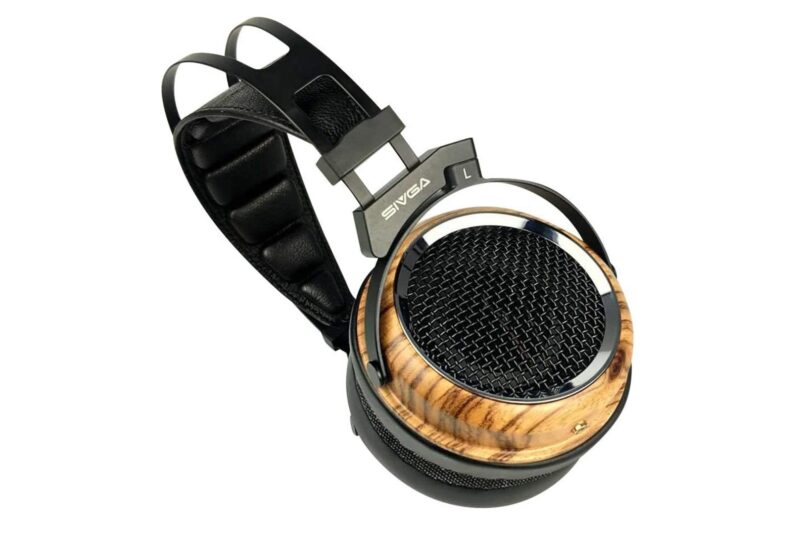Summary
The $255 SIVGA Phoenix is an affordable open-back, over-ear dynamic driver headphone with a beautiful design and crisp, rich sound. The polished zebra wood cups, protein leather, chrome accents, and black lacquer metal frame combine for a luxurious-looking package.
They’re lightweight and comfortable so that you can wear them for long listening sessions, but they just fit larger heads. The 50mm Polycarbonate film driver provides nice air up top without being edgy, natural midrange, and just enough lift on the bottom end to keep things interesting.
There is slight coloration in the lower mids, but you must strain to hear it, and some may find the stock pads are a little bit shallow. In that case, they do offer deeper protein leather replacement pads for about $15, which is quite reasonable.
Overall, it’s a very capable and musical headphone for the price, with a sound signature that plays nice with just about any genre you throw at them. The layering and separation are also really good for a headphone under $300.
If you’re looking for a relatively balanced open-back headphone in this price range, it’s definitely worth a listen.
Disclaimer: The SIVGA Phoenix was sent to us by the manufacturer in exchange for an honest review; we will return them once the review is complete.
Build
Upon opening the box, you’ll find the Phoenix headphones, along with a large zippered hard case, a flexible, tangle-resistant 2.5mm to 3.5mm cable, and a canvas bag to store the cable in.
Picking up the headphones, you’ll see the Phoenix uses a combination metal frame/sliding suspension strap to keep them resting lightly on top of your head, and the clamping force is nicely judged even for a huge noggin like mine.
The padded protein leather suspension strap is nicely cushioned, and due to its relatively small size and aluminum/wood construction, the Phoenix is extremely lightweight. The cups swivel liberally, which allows them to form to your head. All of this adds up to a headphone that is quite comfortable and easy to wear.
However, the compact dimensions do come into play when it comes to head size. With my large head (7 7/8 hat size), the cups just came down over my ears, and I adjusted the strap almost all the way to the top. This didn’t affect comfort; it’s just worth mentioning.
SIVGA is well known for its striking Wood headphone designs, and the polished zebra wood cups utilized on the Phoenix make it easy to see why. They look excellent, and the chrome rings surrounding the steel mesh screens in the center add to the upscale aesthetic.
Inside the cups are 50mm ultra-thin Polycarbonate film drivers which are meant to be very lightweight but able to move precisely without deformation. This helps to provide both extended highs and bass.
The headphones come with hybrid memory foam earpads installed, lined with protein leather both inside and out. On the part that rests against your skin, there is a soft, velvety microfiber. The pads are angled to help with fit.
The earpads are a little on the shallow side, so my ears did make quite a bit of contact with the interior lining. It didn’t bother me, but it’s something to think about if you’re sensitive to that kind of thing.
By the way, if the stock pads do bother you, SIVGA offers protein leather replacement pads that are a little thicker and reduce contact. They are reasonably priced at about $15 and do add a bit of comfort.
Keep in mind, the replacement pads do tip the midbass up a little, which adds a little more warmth, but you sacrifice a bit of midrange clarity and top-end air in exchange. If you buy the Phoenix, I recommend that you invest in a pair to hear both options.
As I alluded to earlier, the included cable, while a little on the thin side, is flexible and tangle-resistant. It also has a nice length to it.
With its high sensitivity and low impedance, it’s also effortless to drive, making it a nice match for small digital audio players and smartphones. Just be careful with high-gain amps because things can get a little noisy.
Listening to the SIVGA Phoenix Headphone
I connected the Phoenix to various gear for my testing, including a $220 Shanling M2x digital audio player, LG V60 Smartphone with ESS Quad DAC, the $99 HELM Bolt USB DAC, and the $649 iFi Micro iDSD Signature transportable DAC.
The latter two were connected to my ENVY X360 laptop playing MQA tracks from the TIDAL desktop app, while I played local high-resolution FLAC files on the DAP and Smartphone. All my sound impressions are based on the sound with the stock pads.
One thing I noticed about these headphones is they sounded good no matter what I hooked them up to, and they scaled up nicely with better sources.
If I had to sum up the Phoenix’s sound, I would say it’s relatively balanced with a tasteful bump in the sub-bass, which adds some nice weight to the presentation. Since they’re pretty flat through most of the audioband, they come out a little on the cool side.
Because they have a little dip in the lower treble, they do come sound a little dark on certain tracks, but not dark enough to sound overly veiled.
For a $300 headphone (now $250), the Phoenix did extremely well with both micro and macro detail, nicely presenting strings with fullness and realism. It did the same with vocals giving me a good helping of Donald Fagen’s soulful delivery on Steely Dan’s “Babylon Sisters.”
I also loved the soundstage and imaging on Eric Clapton’s “Tears In Heaven” from his “Unplugged” album. The stage was pretty wide, with the background singers and guitarists appearing to come from well outside the earcups. The imaging was also relatively focused, especially in the center.
I also liked the dynamics, as demonstrated on Tony Allen’s and Hugh Masekela’s “Robbers, Thugs, and Muggers,” where the full fury of Allen’s drum kit was on display, showcasing the Phoenix’s considerable punch and slam.
The drum hits weren’t as precise as I’ve heard on other (more expensive) headphones, but they were full and pretty defined.
Comparisons
I compared the Phoenix to some of the other headphones I had in the price range, including the Hifiman SUNDARA ($350), the Drop/Sennheiser HD58X Jubilee ($170), and the Meze 99 Classics ($309).
The HD 58X Jubilee was a lot warmer than the Phoenix, with rolled-off highs giving it an overall darker vibe. The Sivga headphone was a lot more complex than the 58X, providing more soundstage width and imaging, as well as top-end detail.
However, the 58X did provide a little more microdetail which added some of the depth the Phoenix is missing. Overall the Phoenix is more engaging, though, and it also wins for build quality. Comfort is a wash.
Moving on to the Meze, the 99 Classic sounded a little more closed in compared to the Phoenix, which is to be expected from a closed-back headphone.
The Meze was a also warmer than the SIVGA headphone with more power and dynamics on the low end, but the bass tends to overpower the mix on some songs, like the Tony Allen drum track mentioned earlier.
The SIVGA was more open, balanced, and had more detail overall. It also sounded a little more natural. That appealed more to me.
However, the Meze would probably appeal more to the bassheads. The Meze also edges the Phoenix out in Build and Comfort.
Even though the Hifiman SUNDARA is a more expensive headphone, I had to see how the Phoenix stacked up vs. the best headphone under $500.
Build and Comfort is pretty much a wash; if anything, the SUNDARA may be a touch more comfortable, especially for big heads like mine. However, some may find the Phoenix more comfortable since it has swiveling cups that mold to your head. The SUNDARA doesn’t.
When it comes to Sound Quality, the SUNDARA is heads and shoulders above the Phoenix, with a lot more separation and depth. However, the Phoenix is actually the more open headphone with a wider soundstage.
Comparing the two lets you hear the slight coloration within the midrange on the Phoenix and its slight lack of precision. But when it comes to musical engagement, the Phoenix matches up pretty well. Its presentation is actually more lively with more punch and slam than the Hifiman, which may win some folks over.
That said, the SUNDARA has just a little more depth, allowing you to hear more “into the music” than the SIVGA headphone.
The Wrap Up
I must say the SIVGA Phoenix is quite an accomplished headphone, especially at its current price of $255. If you can deal with the pads’ shallowness, you will be rewarded with some great sound. I really dig the wide soundstage, natural midrange, and punchy bass. They also look outstanding. For a purchase price around $250, I can recommend it as an affordable audiophile option. But if they cost any more than that, I would say save for the Hifiman Sundara.
As an Amazon Associate, Hifitrends.com may earn from qualifying purchases via links placed throughout the site…this helps us keep the website going! Thanks in advance for your help! Prices are subject to change at any time.

I’m an audio writer who started as a young audio salesman/consumer electronics professional back in the late 90s. That’s where I discovered the magic of 2-Channel sound. My hunger for great sound has led me on a delightful music quest that continues today.










Leave a Reply